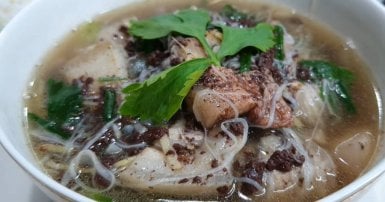Philippine meat dishes embody a diverse and savory culinary landscape deeply influenced by local traditions. Grilled and marinated meats, often seasoned with a blend of indigenous spices and herbs, are a common delight. The art of simmering meat in savory concoctions, like the ubiquitous adobo, reflects a culinary legacy that has evolved over generations. Festive occasions often feature succulent lechon, while sinigang offers a tangy exploration of flavors in a tamarind-based soup. The fusion of Spanish and Chinese culinary influences is evident, creating a unique and flavorful Filipino meat cuisine that harmonizes indigenous ingredients with global inspirations.
Pinikpikan
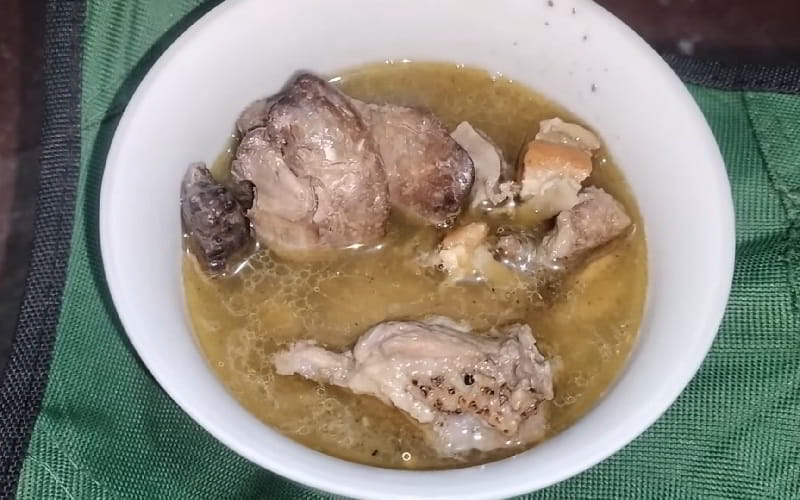
Pinikpikan, a traditional Filipino dish originating from the Cordillera region, is renowned for its unique yet controversial preparation method. The process involves lightly beating a live chicken with a stick before cooking, believed to enhance meat flavor and tenderness. The term "pinikpikan" is derived from the Filipino word "pikpik," meaning to tap or lightly hit. This practice induces stress in the chicken, contributing to the dish's distinct taste. Following this, the chicken is slaughtered, plucked, and prepared for cooking. The traditional method has sparked ethical concerns and criticism from animal welfare advocates. In response, some chefs modify the process, using alternatives to achieve a similar flavor without harming the animal. Despite the controversy, pinikpikan remains a cultural dish in the Cordillera region, with various communities having their own preparation methods.
Sisig

Sisig, a renowned Filipino delicacy hailing from the Pampanga region in Luzon, is crafted from a combination of pork belly, pork jowl, ears (maskara), and chicken liver. The dish is seasoned with chili peppers, calamansi, and onions, creating a flavorful ensemble. The preparation of sisig involves a meticulous three-phase process: boiling, broiling, and grilling. Initially, a pig's head is boiled to eliminate hairs and tenderize the meat. Subsequently, portions are chopped and either grilled or broiled. The final touch includes coarsely chopped onions, served on a sizzling plate. While traditionalists in Pampanga disapprove of deviations like eggs, ox brains, chicharon (pork cracklings), and mayonnaise, these variations have become common. In recent times, local chefs have ventured beyond pork, experimenting with ingredients like chicken, squid, tuna, and tofu, showcasing the dish's adaptability.
Batchoy
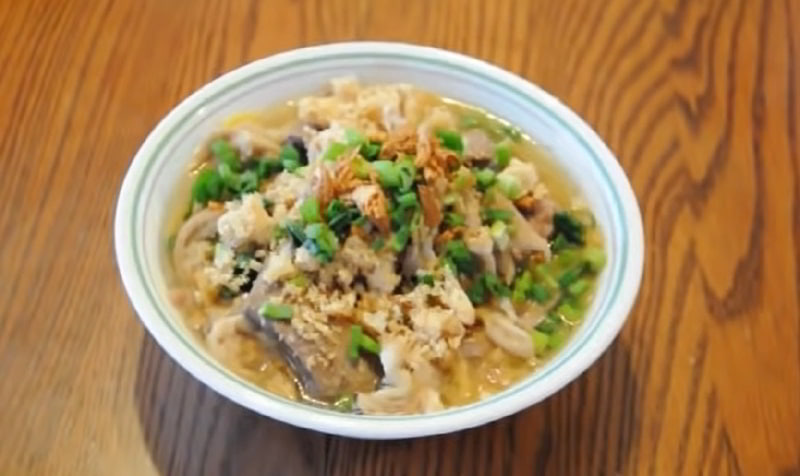
Batchoy is a Filipino noodle soup enriched with chicken stock, crushed pork cracklings, beef loin, round noodles, and pork offal. Its origin lies in the La Paz district of Iloilo City, particularly in the renowned La Paz batchoy variant, gaining widespread popularity. The essential elements of La Paz batchoy comprise pork offal, round egg noodles (miki), crushed pork cracklings, beef loin, and shrimp broth. The cooking procedure involves stir-frying chicken, shrimp, pork organs, and beef in heated oil, incorporating soy sauce. After a brief simmer, the flavorful broth is poured over a bowl of noodles and adorned with pork cracklings (chicharon), sometimes a raw egg, and leeks. Traditional enjoyment involves using a spoon and fork, with the soup relished first to conclude the meal.
Bagnet
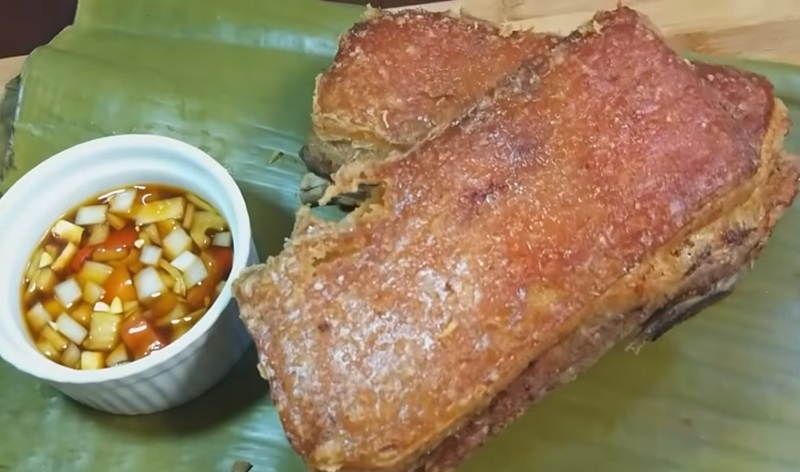
Bagnet, known locally as "chicharon" or "tsitsaron" in Ilocano, is a Filipino delicacy crafted from pork belly, boiled, and deep-fried to achieve a crispy texture. The preparation involves seasoning with garlic, bay leaves, black peppercorns, and salt. After boiling, the meat is left to drain excess moisture thoroughly overnight before frying, resulting in its characteristic chicharon-like crispiness. Bagnet can be enjoyed independently or accompanied by white rice. It also serves as a versatile ingredient, complementing other dishes such as pinakbet and dinardaraan. This savory treat showcases the rich culinary traditions of the Philippines with its flavorful and crunchy profile, making it a popular choice in Filipino cuisine.
Bulalo
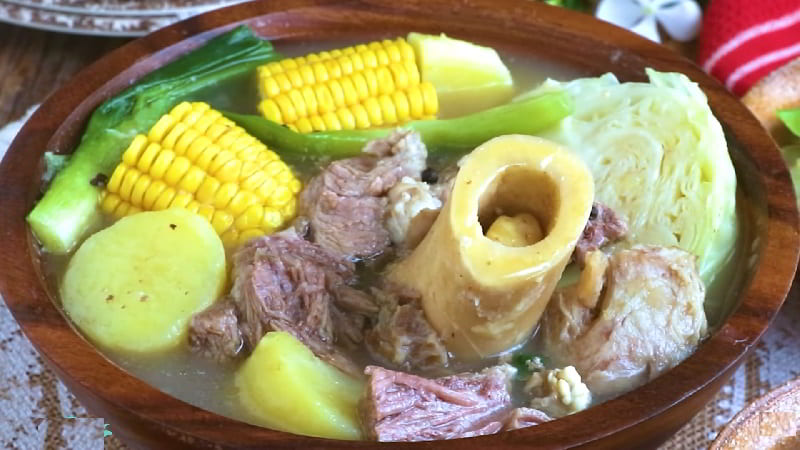
Bulalô, a Filipino beef dish, features a light-colored soup created by simmering beef shanks and bone marrow until their collagen and fat meld into a clear, flavorful broth. The dish typically incorporates leafy vegetables such as pechay or cabbage, ginger, corn on the cob, garlic, scallions, onions, and fish sauce. Additional ingredients like carrots, potatoes, or taro may be included for added depth. Served with rice and accompanied by soy sauce and calamansi on the side, bulalô is a wholesome and comforting meal. The combination of rich broth and hearty ingredients makes it a popular choice in Filipino cuisine, highlighting the country's culinary diversity and appreciation for savory, nourishing dishes.
Chicken Inasal
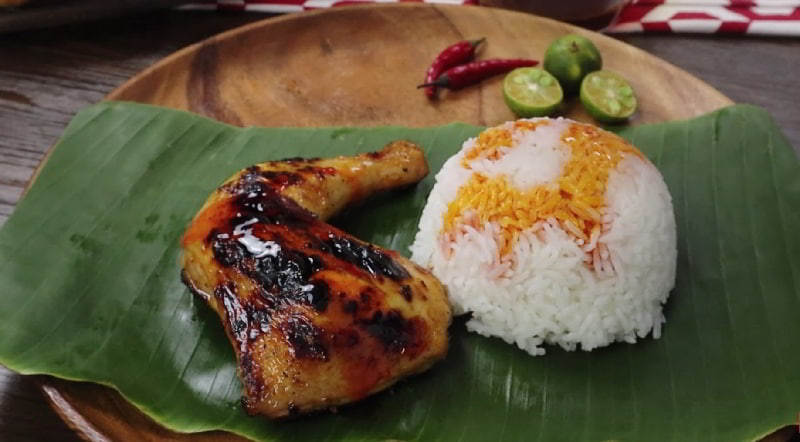
Chicken Inasal, commonly referred to as inasal, represents a variation of the Filipino chicken dish, lechon manok. Inasal typically involves grilling chicken parts, often breast (Pecho) or leg (Paa), while lechon manok consists of a whole stuffed chicken. The chicken is marinated in a blend of coconut vinegar, calamansi, pepper, and annatto before being grilled over hot coals, with intermittent basting using the marinade. Served alongside calamansi, soy sauce, rice, and a side of chicken oil, it is complemented by vinegar, often sinamak vinegar infused with chili peppers, garlic, and langkawas. The distinct flavors and grilling technique contribute to Chicken Inasal's popularity, offering a delightful and savory experience in Filipino culinary traditions.
Arroz Caldo

Arroz caldo is a popular Filipino meat dish that is best described as a savory rice porridge. It is a comforting and hearty dish that is often enjoyed as a breakfast or a warm meal during rainy days. The dish is made by simmering chicken, usually bone-in, in a flavorful broth with garlic, ginger, and onions. As the chicken cooks, it infuses the broth with its rich flavors, creating a delicious base for the dish. The rice is then added and cooked until it becomes soft and creamy, absorbing the flavors of the broth. Arroz caldo is typically garnished with various toppings such as crispy fried garlic, green onions, hard-boiled eggs, and a squeeze of calamansi or lemon juice. Some variations also include additional ingredients like saffron for added color and flavor. The dish is not only delicious but also nourishing, providing warmth and sustenance. It is often enjoyed with a side of condiments like fish sauce or soy sauce for added taste.
Bistek
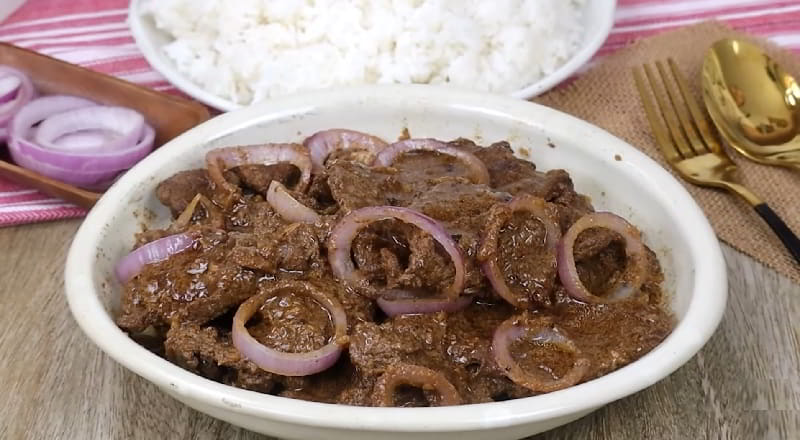
Bistek is a popular meat dish in the Philippines that is beloved for its delicious flavors and simplicity. The dish typically consists of thinly sliced beef, usually sirloin or tenderloin, marinated in a mixture of soy sauce, calamansi juice (a local citrus fruit), and pepper. The marinated beef is then pan-fried until tender and cooked to perfection. The resulting meat is flavorful, tender, and slightly tangy. Bistek is often served with a generous amount of onions, which are caramelized until sweet and fragrant. The onions add a delightful sweetness to the dish and complement the savory flavors of the beef. Some variations of bistek may also include garlic or additional seasonings for added depth of flavor. This dish is commonly enjoyed with steamed rice, and the combination of the tender beef, tangy marinade, and sweet caramelized onions creates a mouthwatering experience.
Lechon Kawali

Lechon Kawali, a Filipino gastronomic delight, showcases pork belly slabs meticulously seasoned and deep-fried in a pan or wok (kawali). The result is a delightfully crisp exterior, preserving a tender and flavorful interior. After cooking, the pork is sliced into cubes for serving. To enhance its savory profile, Lechon Kawali is commonly accompanied by a dipping sauce such as lechon sauce (sarsa ng litson), crafted from vinegar and pork liver, or toyomansi, a blend of soy sauce and calamansi. This dish epitomizes a crispy and succulent treat in Filipino culinary culture, emphasizing the nation's affection for rich and flavorsome culinary traditions.
Humba
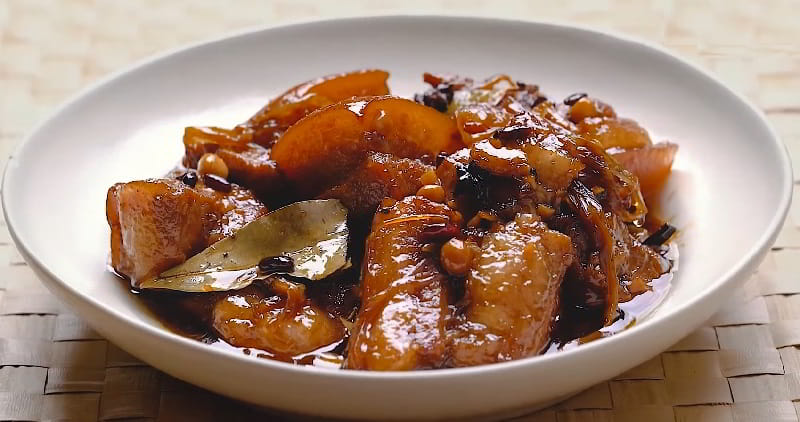
Humbà, or hombà, stands as a Filipino braised pork specialty originating from the Visayas region in the Philippines. The traditional preparation involves slow-cooking pork belly until it achieves remarkable tenderness, using a blend of bay leaves, black peppercorns, soy sauce, vinegar, garlic, and fermented black beans (tausi), sweetened with muscovado sugar. Hard-boiled eggs and banana blossoms are often added to enhance the dish's depth and complexity of flavors. This culinary creation exemplifies the Filipino art of braising, harmonizing the richness of pork with a medley of savory and aromatic ingredients. Humbà is a regional delicacy that showcases the Philippines' diverse and flavorful gastronomic heritage, particularly celebrated in the Visayas region.
Kilawin
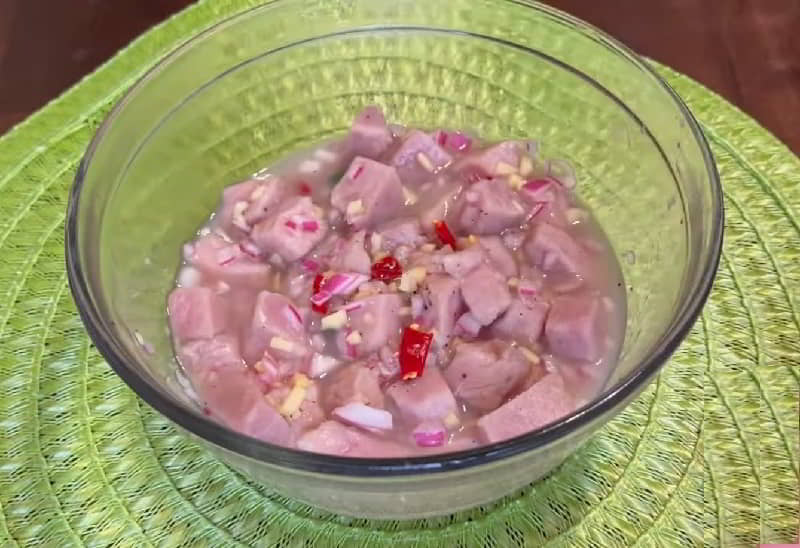
Kilawin is a popular Filipino meat dish known for its vibrant flavors and unique preparation method. It is a type of ceviche that typically features marinated raw meat or seafood, commonly pork, beef, or fish. To make Kilawin, the meat is thinly sliced and then marinated in a mixture of vinegar, calamansi juice, onions, garlic, ginger, and other spices. The acidity of the vinegar and calamansi juice effectively "cooks" the raw meat, giving it a slightly tangy and refreshing taste. What sets Kilawin apart from other ceviche dishes is the addition of various ingredients that enhance its flavor profile. These can include chopped chili peppers for a spicy kick, fresh vegetables like cucumber and tomato for added crunch, and herbs like cilantro or spring onions for a burst of freshness.
Mechado
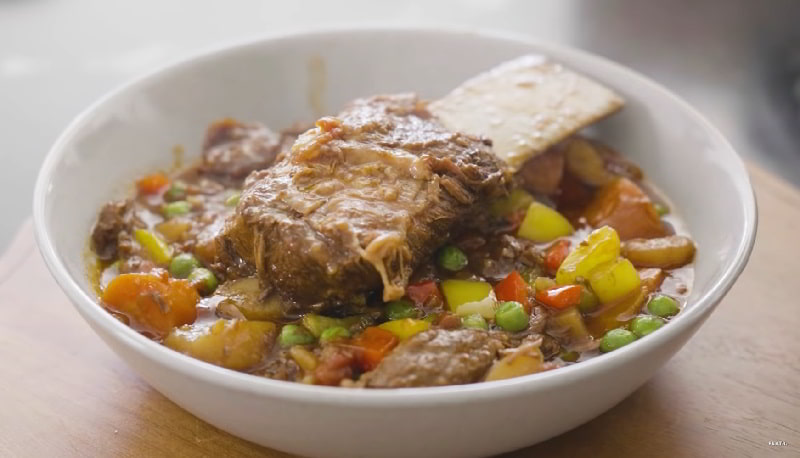
Mechado, a braised beef dish from the Philippines, is influenced by Spanish culinary techniques, reflecting the country's colonial history. The braising liquid is flavored with soy sauce and calamansi fruits. Traditionally, the dish employs a Spanish method of threading strips of pork back-fat ("wicks") through thick cuts of economical beef, like chuck, enhancing succulence. Marinated in soy sauce, calamansi, and black pepper, the larded beef is browned in hot oil before braising in a mixture of beef broth, onions, and bay leaves, resulting in tender meat and a thick gravy. Fish sauce is often added for seasoning, and some versions include tomato sauce in a clay pot. Over time, Mechado has evolved to include variations, resembling a beef stew with thinner slices or bony cuts, featuring tomatoes and potatoes in the braising liquid. Another version, lengua mechada, treats beef tongue similarly, adhering closely to the original method.
Nilaga
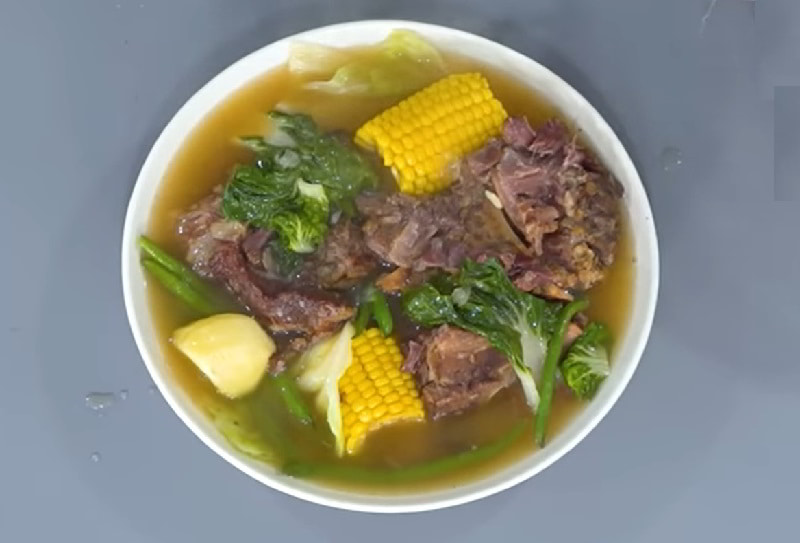
Nilaga is a traditional Filipino meat dish that is loved for its simplicity and comforting flavors. The word "nilaga" translates to "boiled" in English, which perfectly describes the cooking method used for this dish. It is a hearty soup made with tender chunks of meat, typically beef, boiled in a flavorful broth with vegetables. The star ingredient of Nilaga is the meat, usually beef brisket or shank, which is simmered for hours until it becomes incredibly tender and succulent. The broth is made by combining water, onions, garlic, and peppercorns, resulting in a rich and savory base. Carrots, cabbage, potatoes, and sometimes corn are added to the broth to provide additional flavor and texture. Nilaga is a dish that warms the soul and is often enjoyed during rainy days or as a comforting meal for the family. It is commonly served with steamed rice and a dipping sauce made of fish sauce and calamansi.
Hamonado
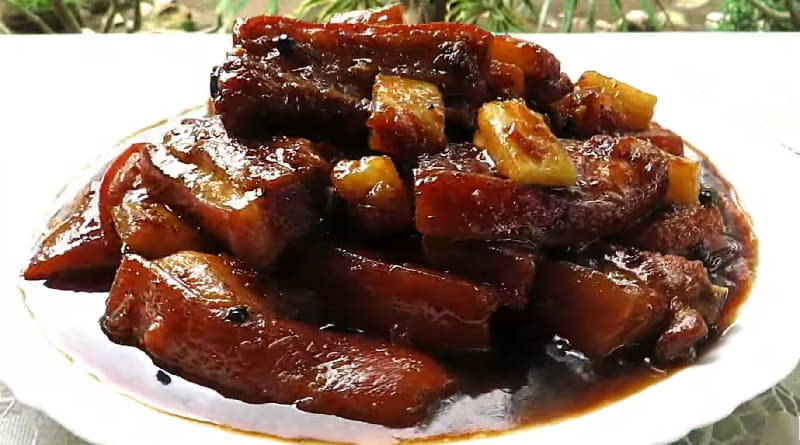
Hamonado is a Filipino culinary delight composed of meat marinated and cooked in a delectably sweet pineapple sauce. Typically using fatty pork cuts, although chicken or beef can also be employed, the dish involves marinating the meat overnight in a sweet concoction comprising pineapple juice, brown sugar, soy sauce, and an array of spices. The marinated meat is pan-fried until it achieves a rich brown hue. Subsequently, the meat undergoes simmering in stock, with additional pineapple chunks, until it reaches a state of utmost tenderness. The completed dish is elegantly presented atop white rice. Hamonado showcases the Philippines' culinary finesse, combining savory and sweet elements to create a harmonious and flavorful dining experience.
Pinapaitan
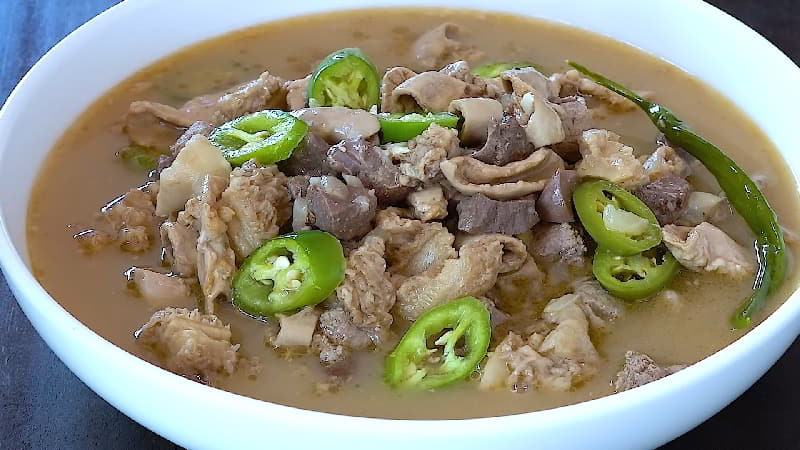
Pinapaitan is a popular meat dish in the Philippines, specifically in the Ilocos region. It is a traditional dish made from various internal organs of a goat or a cow, such as liver, heart, and intestines. The name "pinapaitan" comes from the word "pait," which means bitter in Filipino, referring to the distinct bitter taste of the dish. To prepare pinapaitan, the internal organs are cleaned and boiled until tender. They are then chopped into small pieces and sautéed with onions, garlic, and ginger. Bile, extracted from the gallbladder of the animal, is added to the mixture, giving the dish its bitter flavor. Other ingredients like soy sauce, vinegar, and spices are also added to enhance the taste. Pinapaitan is often served hot and accompanied by steamed rice.
Pata Tim
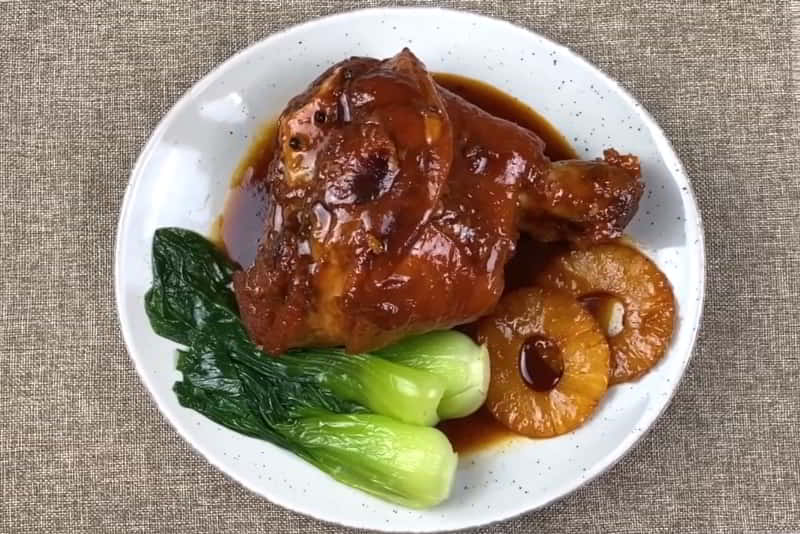
Pata Tim, also spelled Patatim, is a Filipino slow-cooked pork hock delicacy, braised until tender in a savory blend of bay leaves, soy sauce, star anise, black peppercorns, and garlic, sweetened with muscovado sugar. Péchay and mushrooms are commonly added for extra flavor and texture. Unlike humbà, Pata Tim uses whole pork hock, not chopped, and is often marinated overnight in brine. After a brief searing in oil with mushrooms, the hock is set aside. The remaining ingredients—black peppercorns, soy sauce, star anise, muscovado sugar, garlic, and bay leaves—are combined in a pot of water, brought to a boil, and the hock is added. Simmered for hours until exceptionally tender, a pressure cooker can expedite the process. Mushrooms and blanched péchay are added towards the end. Pata Tim is best enjoyed with white rice, showcasing the Philippines' culinary finesse in crafting savory and succulent dishes.
Kadyos, Baboy, Kag Langka
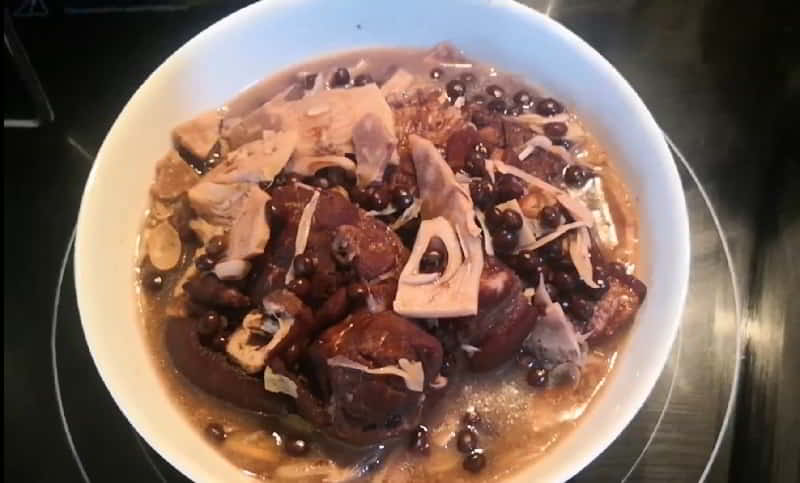
Kadyos, baboy, kag lanka (KBL) is a traditional Filipino pork soup originating from the Hiligaynon people in the Western Visayas islands. The name translates to "pigeon peas, pork, and jackfruit," reflecting the dish's three key ingredients. The soup is authentically flavored with batuan fruits, a type of Garcinia, imparting a distinctive sour taste; however, alternatives like tamarind can also be used. Other components include leafy greens such as cabbage, young sweet potato leaves, or bokchoi, along with onions, lemongrass, fish sauce, and siling haba peppers. Typically featuring pork hock (pata), the dish obtains a characteristic purple hue from the inclusion of pigeon peas. KBL showcases the culinary heritage of the Hiligaynon people, providing a flavorful and vibrant representation of Filipino cuisine.
Lechon Manok
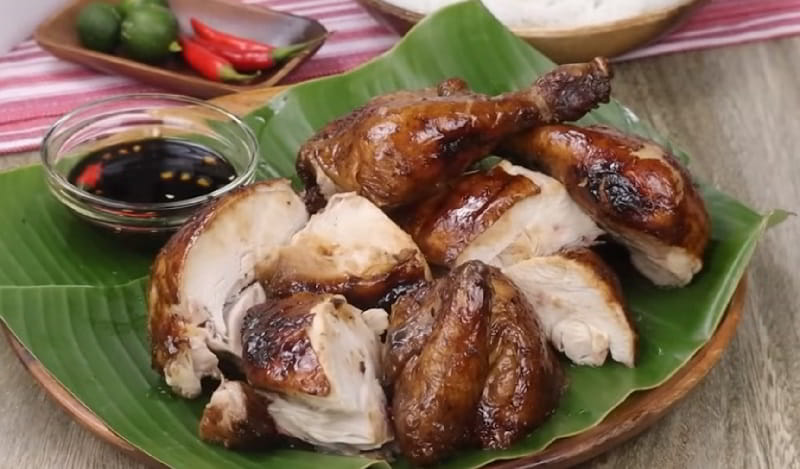
Lechon manok is a Filipino spit-roasted chicken, prepared by marinating chicken in a blend of soy sauce, garlic, onion, bay leaf, black pepper, and patis (fish sauce). Muscovado or brown sugar can be added to sweeten the marinade. The chicken is uniquely stuffed with tanglad (lemongrass) and then roasted over charcoal. It is commonly enjoyed by dipping in a mixture of calamansi, soy sauce, and labuyo chilis known as toyomansi or silimansi. Often served with white rice or puso, it is a popular dish in the Philippines, frequently found at roadside restaurants. Atchara pickles are commonly served as a side dish, enhancing the overall dining experience with a combination of flavors and textures.
Igado
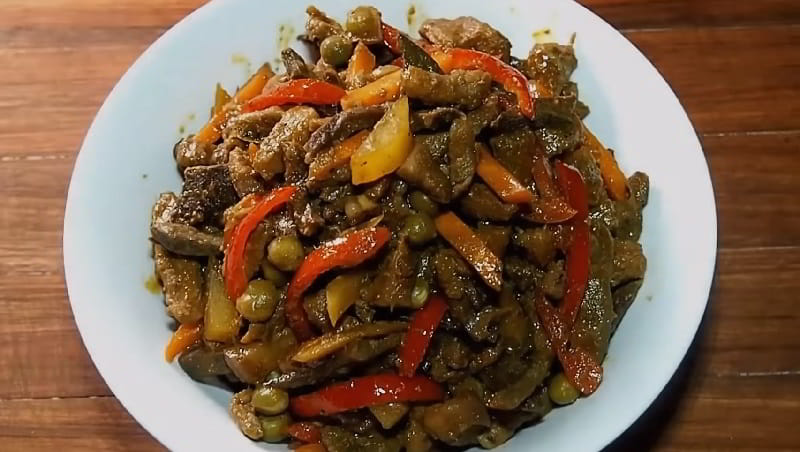
Igado (or higado) is a Filipino pork dish with its roots in the Ilocos Region of the Philippines. Its name, meaning "liver" in Spanish, highlights its primary ingredient, though it may also feature other pork meats. In preparing Igado, the pork— meat, liver, and offal—are finely sliced and simmered with green peas and bell pepper, resulting in a dish often compared to menudo. Diverging from menudo, Igado generally incorporates soy sauce and vinegar instead of tomato sauce. Additionally, the inclusion of potatoes and carrots is optional, showcasing the dish's versatility in accommodating various preferences. Igado exemplifies the rich culinary diversity of Filipino cuisine, offering a savory blend of flavors distinctive to the Ilocos Region.
Binakol
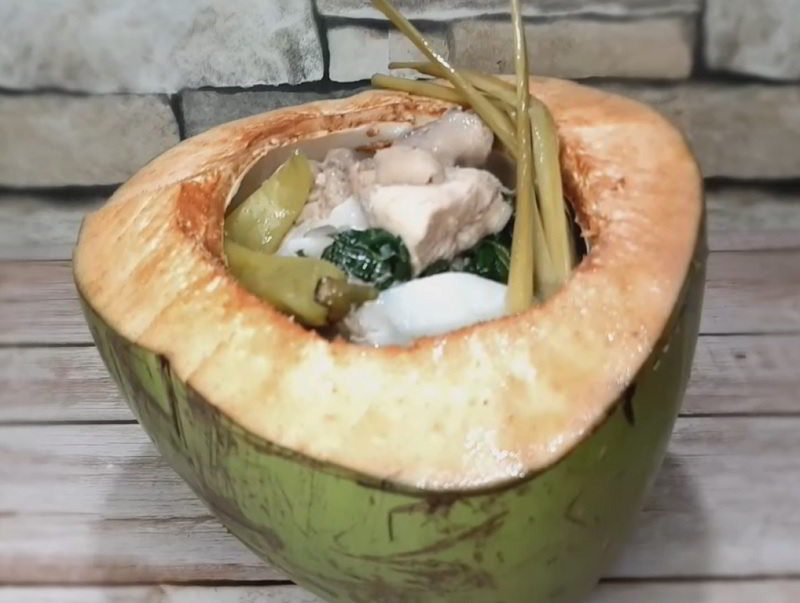
Binakol, also spelled binakoe, is a traditional Filipino chicken soup originating from the Western Visayas, specifically Aklan. It features chicken cooked in coconut water, accompanied by grated coconut, lemongrass, onion, green papaya, ginger, garlic, patis (fish sauce), and leafy vegetables. Optionally, it can be spiced with chilis. Binakol showcases culinary flexibility, allowing for the use of various meats or seafood. Traditionally, it was prepared inside bamboo tubes or directly on halved coconut shells, contributing to its distinct flavor. The dish reflects the rich culinary heritage of the Western Visayas, with the combination of coconut elements, fresh vegetables, and the aromatic blend of spices creating a delightful and savory chicken soup enjoyed in the Filipino gastronomic tradition.
Tuslob Buwa

Tuslob buwa is a distinctive and flavorful meat dish originating from Cebu, Philippines. This culinary creation involves cooking ingredients in a wok (kawa) until the mixture thickens and produces bubbles. The dish is complemented by pusô (hanging rice), which diners dip into the prepared tuslob buwa. Traditionally, it is prepared as a communal food experience. Street food vendors (pungko-pungko) use a single wok, allowing several people to share the dish. Diners contribute by paying for the pusô. This communal aspect not only adds to the uniqueness of tuslob buwa but also enhances the social experience, making it a cherished part of Filipino gastronomy, particularly in the vibrant city of Cebu.
Everlasting
-1709322050.jpg)
Everlasting, also recognized as the Marikina meatloaf, is a Filipino steamed meatloaf with its roots in Marikina. Comprising ground pork, bell peppers, Chorizo de Bilbao sausages, raisins, carrots, onions, pickle relish, tomatoes, and eggs, it mirrors the hardinera meatloaf of Quezon. Traditionally, it undergoes steaming in an oval-shaped tin mold, commonly referred to as a llanera (or lyanera). This culinary delight, known for its unique combination of ingredients, showcases the rich gastronomic heritage of Marikina. The term "everlasting" aptly reflects its enduring popularity and presence in Filipino cuisine, particularly in Marikina, where it stands as a savory representation of the region's culinary traditions.
Pininyahang Manok

Pininyahang manok, commonly referred to as pineapple chicken, is a Filipino dish where chicken is braised in a sauce made with coconut milk, accompanied by potatoes, pineapples, carrots, and bell peppers. Some versions opt for a chicken stock base instead of milk. To prepare Pininyahang manok, the chicken is initially marinated in pineapple juice, although some recipes may skip this step. The marinated chicken is then sautéed with garlic and onions until lightly browned. Subsequently, water infused with a modest amount of condensed milk is added, along with bell peppers, diced carrots, pineapple chunks, and potatoes. Alternatively, coconut milk or cream can replace regular milk. The dish is seasoned with black pepper, salt, sugar, or fish sauce to taste, simmering at low heat until all ingredients are thoroughly cooked.
Philippine Asado
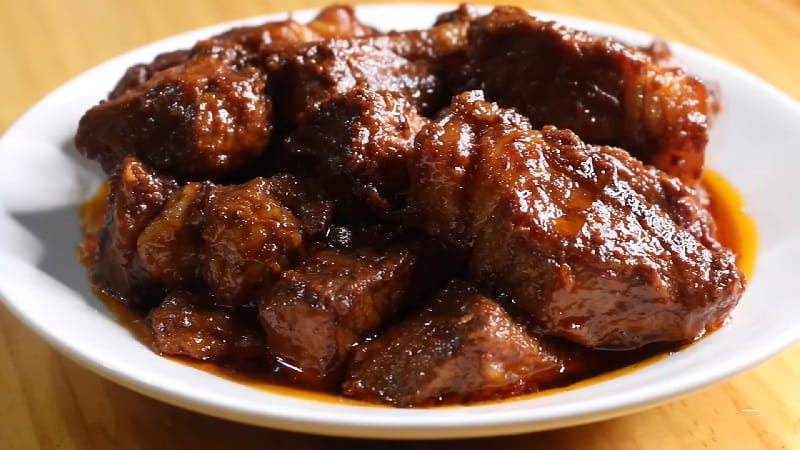
Philippine asado refers to two distinct Filipino braised meat dishes. The name originated from the Spanish term "asado," meaning "grilled," but in the context of these dishes, it now denotes a braising method. One version is derived from the Chinese-Filipino tradition, akin to char siu barbecues, and is commonly known as pork asado. This Filipino adaptation involves marinating and slow-cooking pork in a savory and slightly sweet sauce. The other Filipino dishes also known as asado are asado de carajay and asado matua. Unlike the Chinese-derived version, these Filipino renditions are savory rather than sweet, showcasing the diverse flavors and influences present in Filipino cuisine.
Ginataang Manok

Ginataang manok, a Filipino chicken stew, features chicken cooked in coconut milk with fish sauce (patis) or shrimp paste (bagoong alamang), green papaya, onion, garlic, ginger, various vegetables, and seasoned with pepper and salt. Belonging to the ginataan category, this dish showcases the rich and creamy flavors of coconut milk. A popular variation of the dish incorporates non-native Indian spices, transforming it into Filipino chicken curry. This variant adds an extra layer of complexity to the taste profile, highlighting the adaptability and diversity present in Filipino cuisine. Ginataang manok, whether in its traditional form or as a curry, represents a delicious and comforting aspect of Filipino gastronomy.
Linagpang

Linagpang or nilagpang, originating from the Western Visayas and popular among the Hiligaynon people, is a Filipino cooking technique. It begins with roasting, broiling, or char-grilling chicken or fish, and then incorporating them into a soup featuring onions, scallions, tomatoes, and ginger. Initially devised as a method for utilizing leftover grilled or roasted chicken or fish, linagpang retains this tradition, but it can also be prepared directly. Seasoned with patis (fish sauce), chilis, salt, pepper, or sugar, it may include basil, pechay, or coconut milk. The grilling process imparts a smoky dimension to the soup. In the chicken version (linagpang na manok), native chicken is shredded into flakes, while the fish version known as linagpang na isda features sliced fish chunks with intact skin. Different fish types can be used, such as linagpang na turagsoy (common snakehead), linagpang na bangus (milkfish), and linagpang na tilapia (tilapia).
Estofado
-1703209746.jpg)
Estofado, also known as Estufado or Estofadong Baboy, draws its inspiration from the Spanish term "estofar," meaning "stew." This Filipino dish, akin to Philippine adobo, features stewed pork simmered in a flavorful mixture of vinegar and soy sauce. What sets estofado apart is the addition of fried plantains, carrots, and sausages, contributing to its unique taste and texture. The amalgamation of these ingredients results in a rich and savory stew with a delightful interplay of sweet and savory notes. This culinary creation showcases the Philippines' ability to blend diverse influences, creating a dish that reflects the country's cultural fusion and the artistry found in Filipino cuisine.
Lauya
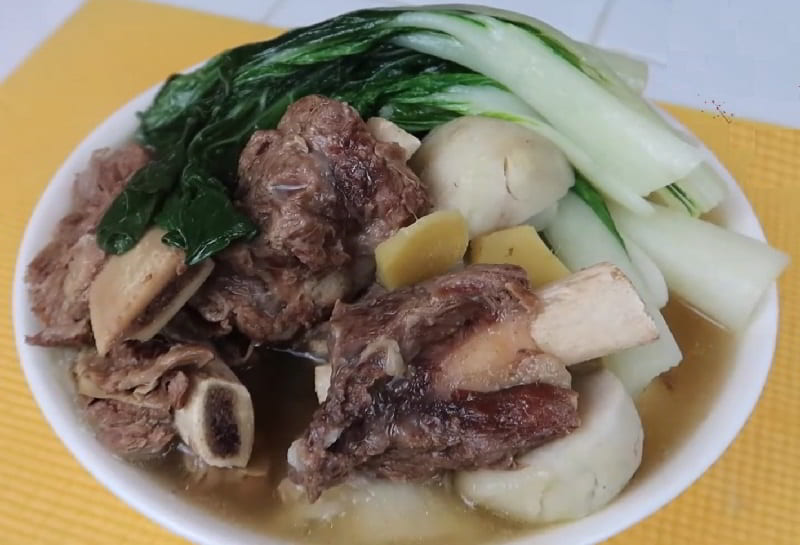
Lauya is a Filipino dish, specifically from the Ilocos region in the Philippines. Lauya is a type of stew, often made with pork ribs or pork belly (although beef can also be used), and various vegetables like potatoes, chayote, and green papaya. The dish is seasoned with fish sauce, garlic, and salt. It is known for its simplicity and the natural flavors extracted from the ingredients during the cooking process. Lauya is commonly enjoyed as a comforting and hearty soup, especially during colder weather or as a nourishing dish. Different regions may have variations of lauya, and it may also be prepared with other ingredients based on local preferences.
Carne Norte Guisado

Carne norte guisado is a Filipino culinary delight crafted from shredded canned corned beef (carne norte) expertly sautéed alongside onion rings. This uncomplicated yet flavorful dish is a breakfast favorite, often paired with white rice or pandesal. The recipe allows for creative variations by incorporating finely diced potatoes, cabbage, carrots, tomatoes, scallions, bell pepper, and garlic, enhancing both the texture and taste. The harmonious blend of ingredients in carne norte guisado makes it a versatile and satisfying meal that caters to personal preferences. Whether enjoyed as a hearty breakfast or a comforting any-time-of-day dish, its simplicity and delectable appeal contribute to its popularity in Filipino cuisine.
Batchoy Tagalog
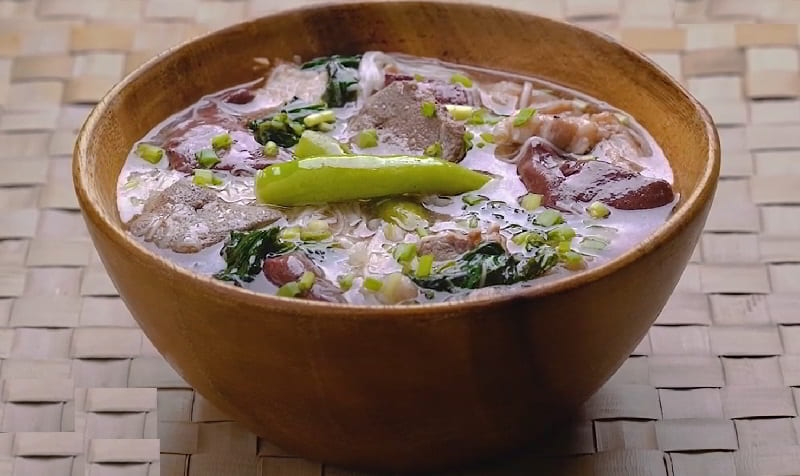
Batchoy Tagalog, also referred to as batsoy, is a classic Filipino dish rooted in the northern Philippines, with the alternate names sutsa or syutsa in Quezon province. This soup presents a rich combination of ingredients, including noodles (typically misua), green chilies, pork, pork offal, pork blood, chili leaves or garlic chives, garlic, onions, and ginger. A versatile and hearty offering, Batchoy Tagalog is commonly enjoyed with cooked rice as a main dish. The distinct blend of flavors and textures in this traditional Filipino cuisine showcases the culinary diversity and regional influences present in the country's gastronomic landscape.
Sinampalukan
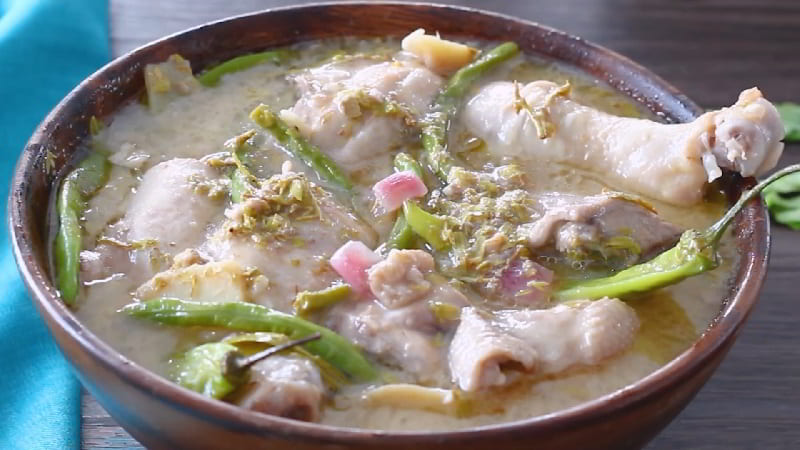
Sinampalukan stands as a Filipino chicken soup celebrated for its vibrant flavors. The dish involves cooking chicken in a tangy broth infused with tamarind, tamarind leaves, ginger, onions, garlic, and assorted vegetables. To prepare sinampalukan, the chicken is initially sautéed with ginger, garlic, and onions. The ensuing step introduces water along with tamarind pulp, young tamarind leaves, and often siling haba or labuyo chilis, complemented by tomatoes. Additional vegetables like cabbage, green beans, pechay, and eggplant can be incorporated based on preference. This delightful creation is commonly served over white rice, cherished as a comfort food, particularly suitable for those feeling unwell or on chilly days.
Piaparan

Piaparan, alternatively called pipaparan, piaran, or piarun, is a Filipino culinary gem renowned for its rich flavors. Typically featuring chicken or seafood, this dish is prepared in a coconut milk-based broth blended with young wild shallots (sakurab), grated coconut, ginger, garlic, onions, turmeric, labuyo chili, and an assortment of vegetables. The distinctive spice is derived from palapa, enhancing the overall taste profile. Originating from the Maranao people of Lanao del Sur, the name "Piaparan" translates to "shredded coconut" in Maranao, emphasizing the integral role coconut plays in the dish. As a delightful variation of ginataan, Piaparan showcases the culinary expertise and regional influences inherent in Filipino cuisine, offering a harmonious blend of textures and aromas.
Tokwa't Baboy

Tokwa't baboy, translated as "tofu and pork" in Tagalog, stands as a popular Philippine appetizer, showcasing a delightful combination of flavors and textures. This dish comprises pork ears, pork belly, and crispy deep-fried tofu, generously bathed in a savory mixture of vinegar, soy sauce, pork broth, scallions, finely chopped white onions, and red chili peppers. Recognized for its versatility, tokwa't baboy is commonly enjoyed as pulutan, representing a delectable finger food to accompany drinks. Additionally, it serves as a satisfying standalone meal when paired with rice or functions as a complementary side dish to rice porridge. This Filipino culinary creation exemplifies the diverse and enticing offerings found in the country's gastronomic landscape.
Piyanggang Manok

Piyanggang manok, also spelled pyanggang manok, represents a Filipino culinary treasure featuring chicken braised in a flavorful blend of coconut milk, lemongrass, turmeric, siling haba chilis, onions, ginger, garlic, and ground burnt coconut. Originating from the Tausug people of Sulu and Mindanao, this dish shares ties with tiyula itum, another Tausug specialty utilizing burnt coconut. The distinctive character of piyanggang manok lies in its characteristic black color, a result of the rich combination of ingredients and the inclusion of burnt coconut. As a testament to the diverse and vibrant culinary traditions of the Philippines, piyanggang manok provides a unique and savory experience, showcasing the cultural richness of the Tausug community.
Inubaran

Inubaran is a Filipino chicken stew that features chicken cooked with gata (coconut milk), diced banana pith, or kakang gata (coconut cream), lemongrass, a souring agent, and an assortment of spices. Traditionally, the souring agent, known as aeabihig, is derived from either batuan fruits (Garcinia morella) or libas leaves (Spondias pinnata). The dish's name, "Inubaran," signifies being cooked with banana pith (ubad). Originating from the Western Visayas and deeply rooted in the Aklanon culinary traditions, it reflects the local flavors and ingredients of the Aklanon people. This versatile dish allows for variations with other meats or seafood, showcasing the adaptability and richness of Filipino cuisine.
Crispy Tadyang ng Baka

Crispy tadyang ng baka is a delectable dish consisting of deep-fried beef ribs, typically served alongside soy sauce and vinegar (toyo't suka) or pickled vegetables (atchara). Recognized as a popular pulutan, this dish is especially enjoyed when paired with beer. Crispy tadyang shares similarities with baby back ribs, but it distinguishes itself by using beef and employing a frying method rather than grilling. The result is a flavorful and crispy delight, offering a delightful combination of textures and tastes. Whether savored as a standalone treat or accompanied by refreshing beverages, crispy tadyang ng baka stands as a delightful addition to Filipino culinary traditions.
Tortang Carne Norte

Tortang carne norte, or corned beef omelet, is a traditional Filipino dish prepared by pan-frying a blend of eggs and shredded canned corned beef (carne norte). This savory delight is typically seasoned with salt and black pepper and may incorporate additional ingredients like garlic, onions, scallions, or sugar for added flavor. Widely enjoyed as a breakfast staple in the Philippines, tortang carne norte pairs well with white rice or pandesal, offering a satisfying start to the day. The dish showcases the fusion of simple yet delicious elements, making it a beloved choice among those seeking a hearty and flavorsome morning meal in Filipino cuisine.
Pork Guisantes

Pork guisantes, or pork and peas, is a pork stew with roots in Filipino cuisine. Contemporary recipes simplify its preparation, incorporating readily available ingredients. Sliced pork, measuring 1 x 1.5 inches, is sautéed in a bit of oil with aromatic vegetables. The dish comes together with the addition of tomato sauce, water, seasonings, and spices, simmering until the pork reaches a tender consistency. Peas are introduced later in the process, contributing freshness to the stew. Finally, the dish is garnished with pimentos, enhancing its visual appeal. This fusion of Filipino and Hawaiian culinary influences results in flavorful and convenient pork guisantes, showcasing the ease of creating a delicious stew with accessible components.
Pinatisan

Pinatisan is a Filipino style of cooking that involves braising meat, typically chicken, pork, or beef, in a mixture of onion, patis (fish sauce), garlic, black peppercorns, ginger, and bay leaves. Some variations introduce unconventional elements such as tomatoes, chili peppers, and additional herbs and spices. Vinegar may also be incorporated, adding complexity to the flavor profile. Pinatisan bears resemblance to binagoongan, which utilizes fermented shrimp (bagoong), a key ingredient in fish sauce. While it shares similarities with Philippine adobo and paksiw, pinatisan stands out due to its reliance on fish sauce over vinegar, as indicated by its name (pinatisan literally translates to "[cooked] with patis"). Notably, pinatisan boasts a robust umami taste, diverging from the typical sour and sweet notes found in adobo.
Talunan
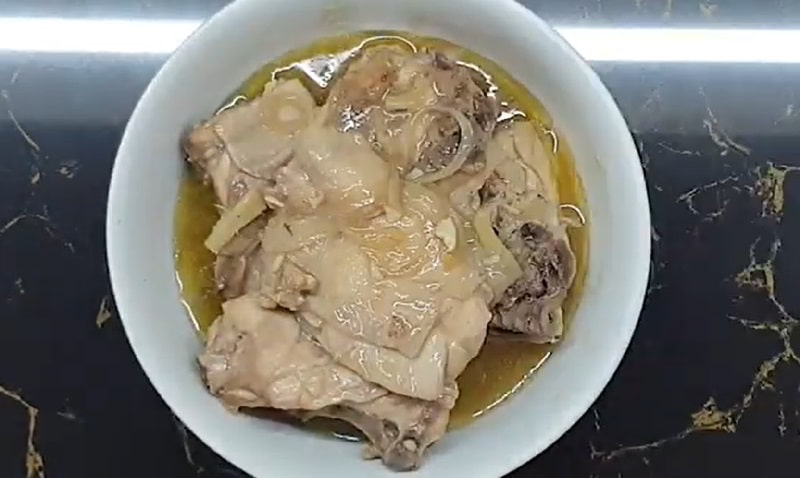
Talunan, also referred to as talonan, stands as a standout in the realm of Filipino culinary arts—a chicken soup or stew celebrated for its sour taste. This gastronomic wonder seamlessly intertwines the rich profiles of Philippine adobo and paksiw, orchestrating a symphony of black peppercorns, vinegar, garlic, bay leaves, ginger, patis (fish sauce), and salt. Some renditions of talunan venture into the realms of creativity by incorporating pork, elevating the dish to new heights with additional layers of flavor and textures. This enchanting amalgamation captures the quintessence of Filipino cuisine, presenting a harmonious dance of savory, sour, and salty undertones. The inclusion of time-honored ingredients in talunan pays tribute to the culinary finesse embedded in Filipino cooking, crafting a dish that not only satisfies but also brings comfort—a perfect choice for diverse occasions.
Kadyos, Manok, Kag Ubad
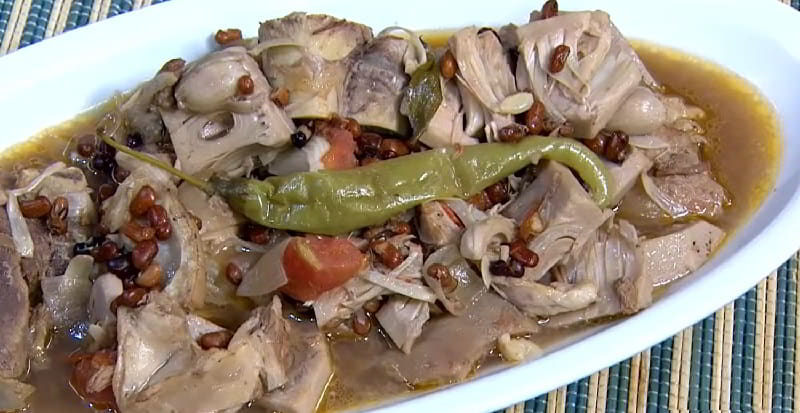
Kadyos, manok, kag ubad (KMU) is a Filipino chicken soup originating from the Hiligaynon people in the Western Visayas islands. The name translates to "pigeon peas, chicken, and banana pith," representing its key components. It bears resemblance to another Hiligaynon dish, Kadyos, baboy, kag langka ("KBL"), however, KMU does not feature any souring agents and incorporates banana pith (ubad) and chicken. The dish, like KBL, attains a characteristic purple hue due to the use of pigeon peas. Alongside thinly sliced ginger, onions, lemongrass, and salt, siling haba pepper, and pepper contribute to the flavorful ensemble, creating a unique and culturally rich culinary experience.
Waknatoy
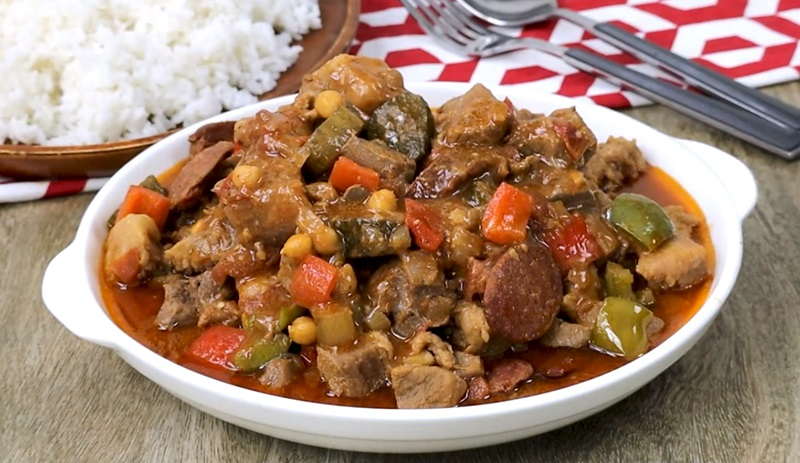
Waknatoy, also known as Marikina menudo, is a Filipino pork stew enriched with the unique addition of pickles. Originating from Marikina, it is a distinctive variation of the traditional Filipino menudo. The dish features cubed pork and pork liver, coupled with sausages, typically Chorizo de Bilbao. Complemented by onions, red and green bell peppers, garlic, tomatoes, and the distinctive inclusion of pickle relish, the ingredients harmonize in a tomato-based sauce seasoned with fish sauce, salt, pepper, and bay leaves. Unlike traditional menudo, Waknatoy excludes vegetables like potatoes and carrots, emphasizing its own distinct flavor profile. However, creative variations may incorporate these additional vegetables to enhance the dish further, offering a delightful and flavorful culinary experience.
Paksiw na Pata

Paksiw na Pata is a Filipino dish featuring pork hock or knuckles cooked in a flavorful and tangy sauce. The dish is prepared by simmering the pork hock in a mixture of vinegar, soy sauce, garlic, onions, bay leaves, and peppercorns until the meat becomes tender. The resulting sauce is rich, savory, and slightly tangy due to the vinegar. Some variations may include the addition of banana blossoms or saba bananas for added texture and sweetness. Paksiw na Pata is appreciated for its distinct taste and the tender meat that easily falls off the bone. This classic Filipino dish showcases the balance of sweet, savory, and tangy flavors that characterize many traditional Filipino recipes.
Binagoongang Baboy

Binagoongan is a Filipino cooking method that involves sautéing or braising vegetables, often water spinach, or meat, commonly pork but occasionally chicken or beef. This process includes black peppercorns, bagoong alamang (shrimp paste), bay leaves, and garlic. To enhance the flavor profile, some recipes incorporate chilis, pineapples, or coconut cream, striking a balance in taste. The dish is renowned for its characteristic saltiness and robust umami flavor, making it an ideal accompaniment to white rice. Due to its intense flavors, Binagoongan is typically not consumed on its own but enjoyed as part of a complete meal, highlighting the Filipino culinary tradition of harmonizing diverse tastes for a satisfying dining experience.
Afritadang Baka

Afritadang Baka is a Filipino beef stew known for its rich and savory tomato-based sauce. This dish features beef chunks cooked with a medley of vegetables such as potatoes, carrots, and bell peppers. The ingredients are sautéed with garlic, onions, and tomatoes to create a flavorful base. The sauce is further enhanced with soy sauce and occasionally vinegar, providing a delightful blend of savory and tangy notes. Afritadang Baka showcases the Filipino culinary art of combining tender meat with a vibrant mix of vegetables, resulting in a hearty and satisfying meal. This classic dish is often served with steamed rice, making it a popular choice among those who appreciate the comforting and delicious flavors of Filipino cuisine.
Afritadang Baboy

Afritadang Baboy is a Filipino pork stew celebrated for its savory and tomato-based sauce. In this dish, pork chunks are meticulously cooked with an array of vegetables, commonly including potatoes, carrots, and bell peppers. The cooking process involves sautéing garlic, onions, and tomatoes to form a flavorful foundation. The sauce is then enriched with soy sauce and occasionally vinegar, creating a harmonious blend of savory and tangy tastes. Afritadang Baboy exemplifies the Filipino culinary tradition of marrying tender pork with a colorful mix of vegetables, resulting in a hearty and satisfying gastronomic experience. Typically served with steamed rice, this classic dish is a favorite among those who relish the comforting and delicious flavors synonymous with Filipino cuisine.
Paksiw na Lechon
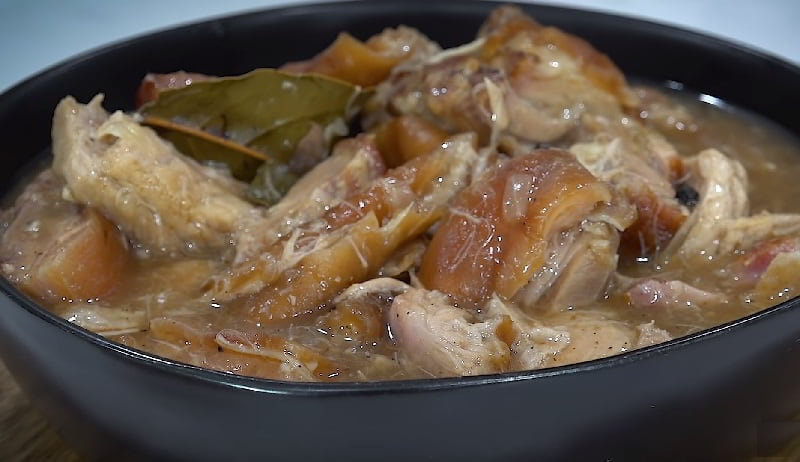
Paksiw na Lechon is a delectable Filipino dish crafted from leftover spit-roasted pork (lechon) immersed in a flavorful concoction of onions, vinegar, black pepper, garlic, and water. The Luzon variant introduces an extra layer of richness by incorporating ground liver or the savory liver spread known as "lechon sauce," enhancing the overall taste. On the other hand, the Visayan versions maintain simplicity by omitting these liver-based elements. This culinary creation ingeniously repurposes lechon leftovers, infusing them with a zesty and savory profile. The dish is celebrated for its regional variations, showcasing the diversity within Filipino cuisine and offering a delightful experience for those seeking a fusion of tender lechon meat with the unique flavors of vinegar and aromatic spices.
Afritadang Manok

Afritadang Manok is a popular meat dish in the Philippines known for its rich flavors and vibrant colors. This dish showcases the Filipino love for hearty and comforting meals. It is a stew made with chicken, potatoes, carrots, bell peppers, and tomatoes, cooked in a flavorful sauce. To prepare Afritadang Manok, chicken pieces are first sautéed until they turn golden brown. Then, a combination of onions, garlic, and tomatoes is added to create a fragrant base. The dish is then simmered in a mixture of soy sauce, vinegar, and chicken broth, infusing the chicken and vegetables with a savory taste. The addition of potatoes and carrots adds a delightful texture and sweetness to the dish, while the bell peppers provide a subtle hint of spiciness. Afritadang Manok is usually served with steamed rice, making it a complete and satisfying meal. This dish is a favorite during gatherings and special occasions, as it is not only delicious but also easy to prepare. Its bold flavors and colorful presentation make Afritadang Manok a standout dish in Filipino cuisine.
Soup Number Five
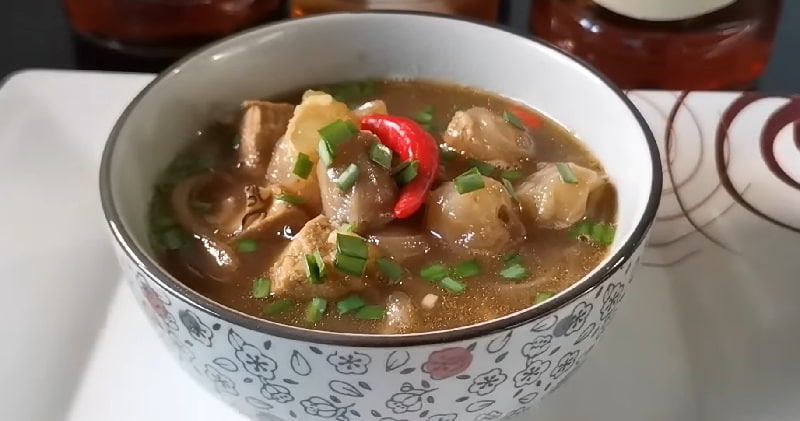
Soup Number Five is a popular meat dish in the Philippines, known for its rich and flavorful broth. It is a traditional soup made from various parts of the bull's anatomy, including the testicles, intestines, tripe, and/or even the penis. Despite its unusual ingredients, the soup is highly regarded for its unique taste and texture. To prepare this dish, the meat parts are first cleaned thoroughly and boiled for several hours until they become tender. The broth is then enhanced with aromatic spices and herbs, such as garlic, onions, and ginger, which add depth and complexity to the soup. The resulting broth is hearty and savory, with a slightly gelatinous consistency. It is believed to have aphrodisiac properties, making it a popular choice among locals seeking to boost their vitality.
Tinola
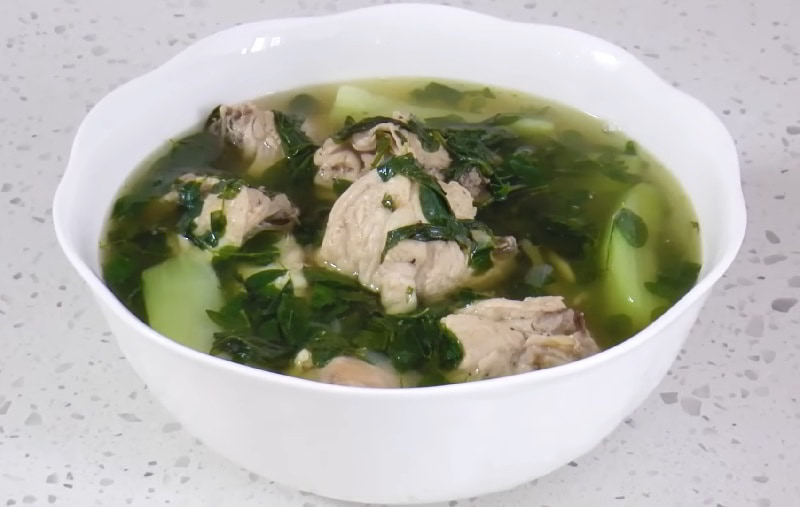
Tinola is a popular Filipino meat dish that is loved for its comforting flavors and nourishing qualities. This traditional dish is typically made with chicken, but it can also be prepared with fish. The main ingredients of Tinola include meat, green papaya, and chili leaves, which are cooked in a ginger-infused broth. To prepare Tinola, the meat is first sautéed with onions and garlic until it is lightly browned. Ginger is then added to the mix, creating a fragrant and flavorful base. Water is poured in, along with the green papaya, which adds a subtle sweetness to the dish. The broth is simmered until the meat is tender and the flavors have melded together. Chili leaves are added towards the end of the cooking process, giving the Tinola a fresh and slightly spicy taste. This dish is often enjoyed with steamed rice, which helps to soak up the delicious broth. The combination of tender meat, flavorful broth, and crisp vegetables makes Tinola a comforting and satisfying meal for Filipinos.









